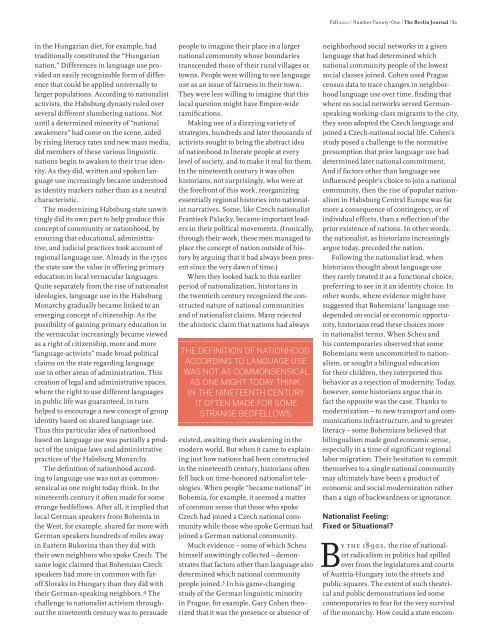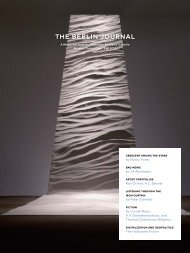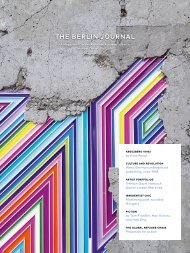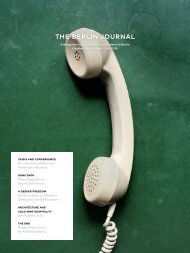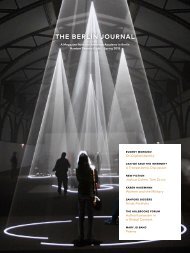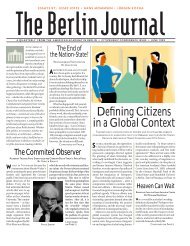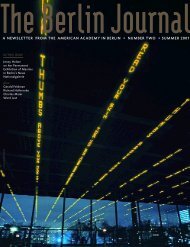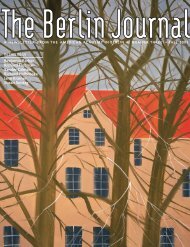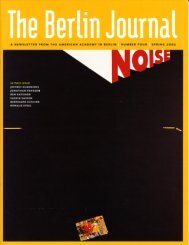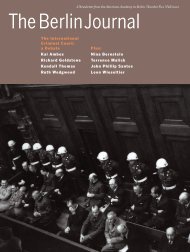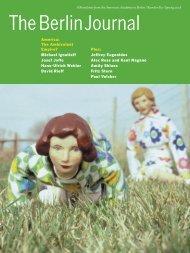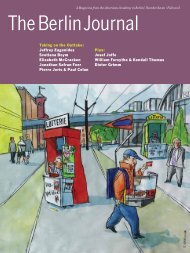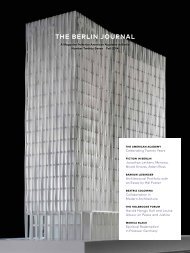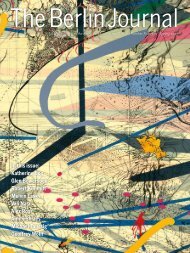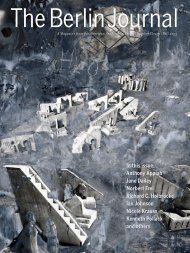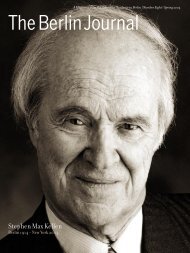Fall 2011 | Issue 21
- No tags were found...
You also want an ePaper? Increase the reach of your titles
YUMPU automatically turns print PDFs into web optimized ePapers that Google loves.
<strong>Fall</strong> <strong>2011</strong> | Number Twenty-One | The Berlin Journal | 31<br />
in the Hungarian diet, for example, had<br />
traditionally constituted the “Hungarian<br />
nation.” Differences in language use provided<br />
an easily recognizable form of difference<br />
that could be applied universally to<br />
larger populations. According to nationalist<br />
activists, the Habsburg dynasty ruled over<br />
several different slumbering nations. Not<br />
until a determined minority of “national<br />
awakeners” had come on the scene, aided<br />
by rising literacy rates and new mass media,<br />
did members of these various linguistic<br />
nations begin to awaken to their true identity.<br />
As they did, written and spoken language<br />
use increasingly became understood<br />
as identity markers rather than as a neutral<br />
characteristic.<br />
The modernizing Habsburg state unwittingly<br />
did its own part to help produce this<br />
concept of community or nationhood, by<br />
ensuring that educational, administrative,<br />
and judicial practices took account of<br />
regional language use. Already in the 1750s<br />
the state saw the value in offering primary<br />
education in local vernacular languages.<br />
Quite separately from the rise of nationalist<br />
ideologies, language use in the Habsburg<br />
Monarchy gradually became linked to an<br />
emerging concept of citizenship. As the<br />
possibility of gaining primary education in<br />
the vernacular increasingly became viewed<br />
as a right of citizenship, more and more<br />
“language-activists” made broad political<br />
claims on the state regarding language<br />
use in other areas of administration. This<br />
creation of legal and administrative spaces,<br />
where the right to use different languages<br />
in public life was guaranteed, in turn<br />
helped to encourage a new concept of group<br />
identity based on shared language use.<br />
Thus this particular idea of nationhood<br />
based on language use was partially a product<br />
of the unique laws and administrative<br />
practices of the Habsburg Monarchy.<br />
The definition of nationhood according<br />
to language use was not as commonsensical<br />
as one might today think. In the<br />
nineteenth century it often made for some<br />
strange bedfellows. After all, it implied that<br />
local German speakers from Bohemia in<br />
the West, for example, shared far more with<br />
German speakers hundreds of miles away<br />
in Eastern Bukovina than they did with<br />
their own neighbors who spoke Czech. The<br />
same logic claimed that Bohemian Czech<br />
speakers had more in common with faroff<br />
Slovaks in Hungary than they did with<br />
their German-speaking neighbors . 4 The<br />
challenge to nationalist activism throughout<br />
the nineteenth century was to persuade<br />
people to imagine their place in a larger<br />
national community whose boundaries<br />
transcended those of their rural villages or<br />
towns. People were willing to see language<br />
use as an issue of fairness in their town.<br />
They were less willing to imagine that this<br />
local question might have Empire-wide<br />
ramifications.<br />
Making use of a dizzying variety of<br />
strategies, hundreds and later thousands of<br />
activists sought to bring the abstract idea<br />
of nationhood to literate people at every<br />
level of society, and to make it real for them.<br />
In the nineteenth century it was often<br />
historians, not surprisingly, who were at<br />
the forefront of this work, reorganizing<br />
essentially regional histories into nationalist<br />
narratives. Some, like Czech nationalist<br />
Frantisek Palacky, became important leaders<br />
in their political movements. (Ironically,<br />
through their work, these men managed to<br />
place the concept of nation outside of history<br />
by arguing that it had always been present<br />
since the very dawn of time.)<br />
When they looked back to this earlier<br />
period of nationalization, historians in<br />
the twentieth century recognized the constructed<br />
nature of national communities<br />
and of nationalist claims. Many rejected<br />
the ahistoric claim that nations had always<br />
THE DEFINITION OF NATIONHOOD<br />
ACCORDING TO LANGUAGE USE<br />
WAS NOT AS COMMONSENSICAL<br />
AS ONE MIGHT TODAY THINK.<br />
IN THE NINETEENTH CENTURY<br />
IT OFTEN MADE FOR SOME<br />
STRANGE BEDFELLOWS.<br />
existed, awaiting their awakening in the<br />
modern world. But when it came to explaining<br />
just how nations had been constructed<br />
in the nineteenth century, historians often<br />
fell back on time-honored nationalist teleologies.<br />
When people “became national” in<br />
Bohemia, for example, it seemed a matter<br />
of common sense that those who spoke<br />
Czech had joined a Czech national community<br />
while those who spoke German had<br />
joined a German national community.<br />
Much evidence – some of which Scheu<br />
himself unwittingly collected – demonstrates<br />
that factors other than language also<br />
determined which national community<br />
people joined . 5 In his game-changing<br />
study of the German linguistic minority<br />
in Prague, for example, Gary Cohen theorized<br />
that it was the presence or absence of<br />
neighborhood social networks in a given<br />
language that had determined which<br />
national community people of the lowest<br />
social classes joined. Cohen used Prague<br />
census data to trace changes in neighborhood<br />
language use over time, finding that<br />
where no social networks served Germanspeaking<br />
working-class migrants to the city,<br />
they soon adopted the Czech language and<br />
joined a Czech-national social life. Cohen’s<br />
study posed a challenge to the normative<br />
presumption that prior language use had<br />
determined later national commitment.<br />
And if factors other than language use<br />
influenced people’s choice to join a national<br />
community, then the rise of popular nationalism<br />
in Habsburg Central Europe was far<br />
more a consequence of contingency, or of<br />
individual efforts, than a reflection of the<br />
prior existence of nations. In other words,<br />
the nationalist, as historians increasingly<br />
argue today, preceded the nation.<br />
Following the nationalist lead, when<br />
historians thought about language use<br />
they rarely treated it as a functional choice,<br />
preferring to see in it an identity choice. In<br />
other words, where evidence might have<br />
suggested that Bohemians’ language use<br />
depended on social or economic opportunity,<br />
historians read these choices more<br />
in nationalist terms. When Scheu and<br />
his contemporaries observed that some<br />
Bohemians were uncommitted to nationalism,<br />
or sought a bilingual education<br />
for their children, they interpreted this<br />
behavior as a rejection of modernity. Today,<br />
however, some historians argue that in<br />
fact the opposite was the case. Thanks to<br />
modernization – to new transport and communications<br />
infrastructure, and to greater<br />
literacy – some Bohemians believed that<br />
bilingualism made good economic sense,<br />
especially in a time of significant regional<br />
labor migration. Their hesitation to commit<br />
themselves to a single national community<br />
may ultimately have been a product of<br />
economic and social modernization rather<br />
than a sign of backwardness or ignorance.<br />
Nationalist Feeling:<br />
Fixed or Situational?<br />
By the 1890s, the rise of nationalist<br />
radicalism in politics had spilled<br />
over from the legislatures and courts<br />
of Austria-Hungary into the streets and<br />
public squares. The extent of such theatrical<br />
and public demonstrations led some<br />
contemporaries to fear for the very survival<br />
of the monarchy. How could a state encom-


